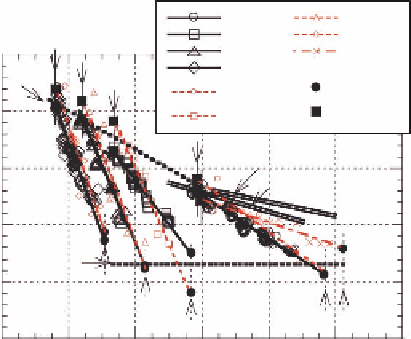Geoscience Reference
In-Depth Information
TS(HC)
G25(HC)
G50(HC)
G75(HC)
TS(LC)
G25(LC)
G50(LC)
G75(LC)
TKS(LC)
e
min
500
Vs
0max
Vs
0min
Vs
0max
400
Hardin-Richart(1963)
Hardin-Richart(1963)
Quartz sand: Vs(e)=328-110e
Hardin-Richart(1963)
Quartz sand: Vs(e)=328-110e
Ottawa sand: Vs(e)=350-161e
Quartz sand: Vs(e)=328-110e
Ottawa sand: Vs(e)=350-161e
300
Ottawa sand: Vs(e)=350-161e
200
Vs
0min
100
e
max
0
0
0.2
0.4
0.6
0.8
1
1.2
Void ratio: e
Fig. 8.7. Normalized S-wave velocity versus void ratiofor five tested soils
(modified fromKokusho and Yoshida, 1997)
Thus, it is obvious that the S-wave velocities of granular soils are not determined by a
unique function of void ratiobut highly variable witha difference inparticle gradation.
In order to formulate the S-wave velocity of granular soils with widely different particle
gradations,normalizedS-wavevelocitiescorrespondingto
e
max
and
e
min
(seeTable8.1),
denoted as
Vs
0
min
and
Vs
0
max
, respectively, were introduced. These values were deter-
mined at junctions of diagonal straight lines approximating the data points with vertical
linesof
e
max
and
e
min
(indicatedbythearrows)andplottedinFigure8.7withlargesolid
symbols; circles for
Vs
0
min
and squares for
Vs
0
max
, respectively. It should be noted in
Figure 8.7 that
Vs
0
min
, despite some scatters, tends to be almost stable, while
Vs
0
max
obviouslyincreasesastheuniformitycoefficient
Cu
ofsoilincreasesfrompoorly-graded
sands to well-graded gravels. In other words, the minimum S-wave velocity of well-
gradedgravelswillremainatalmostthesamelevelasthatofpoorly-gradedsandsdespite
muchlowervoidratiothansands.ThisfindingmayhelptoexplainwhytheS-waveveloc-
ityinthedebrisflowgravelinMoricouldtakeaslowas60-90m/s(Kokushoetal.,1995).
In contrast, the maximum S-wave velocity of well-graded gravels tends to increase con-
siderablywithincreasing
Cu
.Thevaluesof
Vs
0
min
and
Vs
0
max
areplottedagainst
Cu
in
thesemi-logarithmicplotinFigure8.8.Theseplotscanbeapproximatedbysimpleequa-
tionsindicatedonthechart.Thepower
m
inEq.(8.1)obtainedbyregressionanalysiscan
be assumed almost constant as
m
125 (Kokusho and Yoshida, 1997). Thus, S-wave
velocity of granular soils including poorly-graded sands and well-graded gravels may be
formulated by the next equation.
=
0
.
D
r
]
σ
v
/
p
0
σ
h
/
p
0
0
.
125
Vs
=
[136
+ {
440
Cu
/(
Cu
+
1
.
4
)
−
136
}
(8.2)

